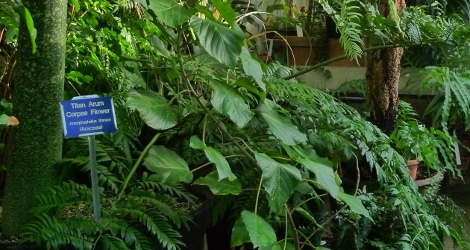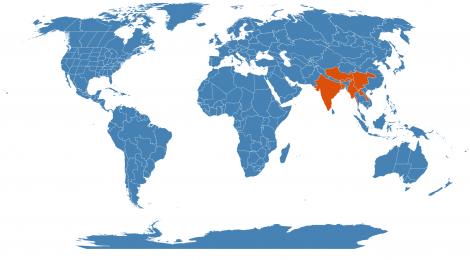Accession Data:
Piper sylvaticum Roxb.
- Common Name: Pahari Pipul, Mountain Long Pepper
- Family: Piperaceae Agardh.
- Description: Climbers herbaceous, dioecious. Stolons present. Stems ridged and furrowed when dry, very finely powdery pubescent when young. Petiole 1-7 cm, very finely powdery pubescent; prophylls 1/2 as long as petioles or slightly longer; leaf blade usually ovate, those at apex of stem ovate-lanceolate, 8-11 × 4-8.5 cm, papery, densely glandular, glabrous except for densely finely powdery pubescent veins abaxially and sometimes base of midvein adaxially, base cordate, symmetric, apex acuminate; veins 7, apical pair arising 0.7-1.5 cm above base, others basal; reticulate veins large, conspicuous, veinlets ascending Spikes leaf-opposed. Male spikes slender, 5-8 cm; bracts orbicular, peltate. Stamens 4; filaments short; anthers reniform. Female spikes erect, 1.5-2.5 cm × 3-4 mm; peduncle 0.5-2 cm, very finely powdery pubescent; bracts orbicular, ± sessile, adaxially pubescent; rachis pubescent, ca. 1.5 mm in diam. Ovary globose, distinct; stigmas 2 or 3, ovate, apex acuminate. Drupe globose, ca. 3 mm in diam., inserted within excavations of rachis. Fl. Aug-Sep.2
- USDA Zone: 10-11
Accession Data:
- Accession # 201100279
- Source: Black Jungle
- Accession Date: 10-19-2011
- Bench: 3116 - EVO: Propagation - Mist
- Currently: active - healthy
- Qty: 1 confirmed on 05-17-2025
Classification:
- Division: Magnoliophyta
- Class: Magnoliopsida
- SubClass: magnoliids
- Order: Piperales
- SubOrder:
- Family: Piperaceae
- SubFamily: Piperoideae
- Tribe:
- SubTribe:
Flowering Data:
This accession has been observed in bloom on:| Year | Jan | Feb | Mar | Apr | May | Jun | Jul | Aug | Sep | Oct | Nov | Dec | ||||||||||||||||||||||||||||||||||||||||
|---|---|---|---|---|---|---|---|---|---|---|---|---|---|---|---|---|---|---|---|---|---|---|---|---|---|---|---|---|---|---|---|---|---|---|---|---|---|---|---|---|---|---|---|---|---|---|---|---|---|---|---|---|
| 2025 | ||||||||||||||||||||||||||||||||||||||||||||||||||||
| 2024 | ||||||||||||||||||||||||||||||||||||||||||||||||||||
| 2023 | ||||||||||||||||||||||||||||||||||||||||||||||||||||
| 2022 | ||||||||||||||||||||||||||||||||||||||||||||||||||||
| 2021 | ||||||||||||||||||||||||||||||||||||||||||||||||||||
| 2020 | ||||||||||||||||||||||||||||||||||||||||||||||||||||
| 2019 | ||||||||||||||||||||||||||||||||||||||||||||||||||||
References (internal):
- EEB Greenhouse Holdings native to: China South-Central / Tibet / Bangladesh / East Himalaya / India / Laos / Myanmar
References (external):
- The Plant List (2013). Version 1.1 Last accessed on Tuesday, February 07, 2017.
- Piper sylvaticum in eFloras - Flora of China. Accessed 19 May 2015.
- Piper sylvaticum at Global Biodiversity Information Facility. Last accessed on Tuesday, February 07, 2017.
data regenerated on Sat, 17 May 2025 12:36:06 -0400 [bcm v4.0]
Images:

Additional images for this accession:
Click on thumbnails to enlargeCurrent Accessions in the Piperaceae
Subfamily Piperoideae
- Peperomia acuminata

- Peperomia amphiplexus

- Peperomia clusiifolia
- Peperomia dahlstedtii

- Peperomia dolabriformis


- Peperomia glabella

- Peperomia incana

- Peperomia obtusifolia


- Peperomia prostrata


- Peperomia resediflora

- Peperomia rubella

- Peperomia unidentified
- Peperomia urocarpa

- Piper arboreum

- Piper cenocladum


- Piper nigrum


- Piper sylvaticum

 = indicates flowering in past 14 days
= indicates flowering in past 14 days
 = images available for this accession
= images available for this accession
 = map available for this accession
= map available for this accession
 = accession added within past 90 days
= accession added within past 90 days
